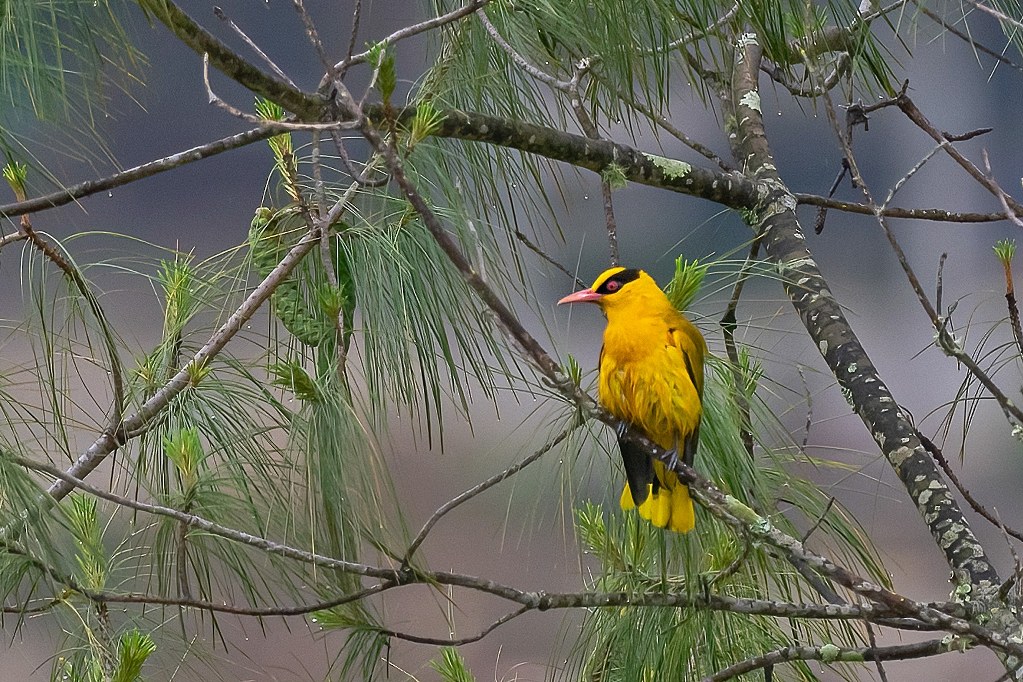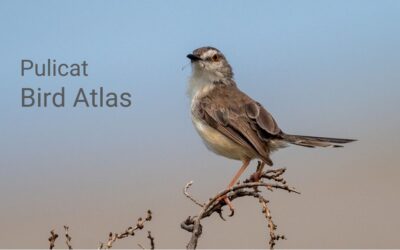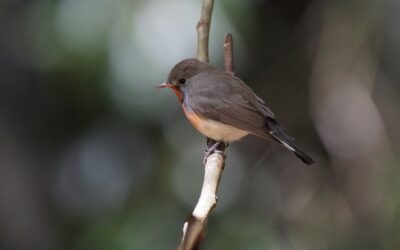Summary
In the third edition of the Himalayan Bird Count on 11 May, 2024, around 368 eBirders from India, Nepal, and Bhutan uploaded 1,191 checklists and recorded an impressive 644 species!
We extend our heartfelt gratitude to all the HBC coordinators who planned, organised, and led birding activities in their regions. Congratulations to everyone who participated in this incredible event!
Below are the results from this single-day birding event, along with an overview of how the Himalayan Bird Count has evolved from its inception in 2022 to the 2024 event.
Table 1: Overall summary from all 3 countries participating in HBC 2024
| HBC 2024 | India | Nepal | Bhutan |
| Total checklists | 950 | 161 | 80 |
| Participants | 264 | 62 | 42 |
| Species | 607 | 350 | 294 |
Table 2: Top 30 participants from India, Nepal and Bhutan
| Participant Name | # Lists |
| Micah Rai | 26 |
| Aity Thapa | 25 |
| Ahmad Faiz Mustafa | 24 |
| Dambar Kumar Pradhan | 17 |
| Yubin Shrestha | 16 |
| Sewangi Sewangi | 16 |
| Vijaya Lakshmi | 16 |
| Rohit Rai | 15 |
| Padma Gyalpo | 14 |
| Deepak Budhathoki Ðÿ¦‰ | 14 |
| Urgen Yonzon Yonzon | 13 |
| Prasanna Kalita | 13 |
| Arunava Dutta | 13 |
| Runa Dutta | 13 |
| Chewang Bonpo | 13 |
| Dibyendu Ash | 13 |
| Amitava Dutta | 13 |
| Aditi Sarkar | 13 |
| Anupam Nahardeka | 12 |
| Sumathy Venkatraman | 12 |
| Argrit Boonsanguan | 11 |
| Rajendra Koranga | 10 |
| Choldan Gasha | 9 |
| Chaiti Banerjee | 9 |
| Babloo Farswan | 9 |
| Madhu Gupta | 8 |
| Dr Mohammed Umer Sharieff | 8 |
| Anju Dhakal | 8 |
| Kiran Gosai | 8 |
| Sanjit Kumar Mitra | 8 |
Table 3: Participants who uploaded more than 5 lists from India, Nepal and Bhutan
| Country | Participant Name | Region | # Lists |
| India | Micah Rai | Arunachal Pradesh | 26 |
| India | Ahmad Faiz Mustafa | Himachal Pradesh | 24 |
| India | Vijaya Lakshmi | West Bengal | 16 |
| India | Yubin Shrestha | Bagmati | 16 |
| India | Padma Gyalpo | Ladakh | 14 |
| India | Arunava Dutta | Sikkim | 13 |
| India | Rajendra Koranga | Uttarakhand | 10 |
| India | Dr Mohammed Umer Sharieff | Jammu and Kashmir | 8 |
| Nepal | Manshanta Ghimire | Gandaki | 7 |
| Nepal | Samyam Rumba | Province 1 | 5 |
In the map below, each list contributed to HBC is shown as a translucent circle. Deeper yellow indicates overlapping circles, which signals more lists from that location.
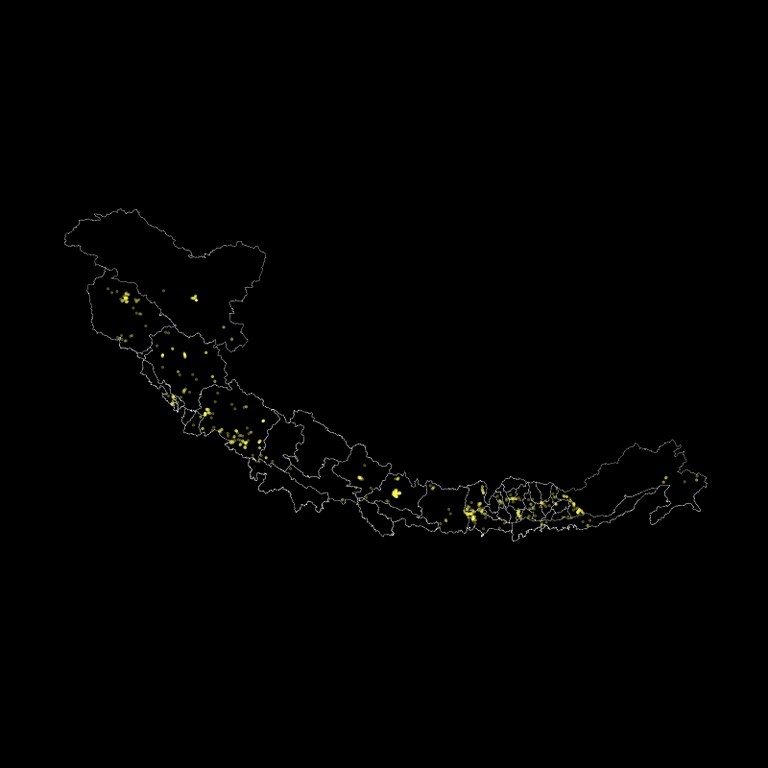
Fig.1: eBird Coverage Map of HBC 2024.
The country, state/union territories, and district-level coverage of HBC 2024 based on checklists are shown below. To view the summary (number of checklists, participants, species), please click on a country, state, or district in these zoomable maps.
Disclaimer: Each HTML file is 11 MB. Be mindful of data usage when downloading, especially on mobile. Best viewed on a computer.
Fig. 2: HBC 2024 State/UT coverage. To see the HBC summary for any state/ province, zoom in and click on the specific region.
Fig. 3: HBC 2024 District coverage. To see the HBC summary for any region, zoom in and click on the specific region.
What were the common species reported?
Here’s a glimpse at some of the most frequently reported species in each region.
The Himalayan Bulbul reigned supreme in the Western Region, while the Red-vented Bulbul took the top spot in the Central Region. Common Mynas were in top five in both the Western and Central regions but were less common in the Eastern Region.
Feral pigeons were a frequent sight only in the Western Region. Cuckoos were less prominent in the Western Region, but Asian Koel, Large Hawk-Cuckoo, and Lesser Cuckoo were all reported in the Central and Eastern regions.
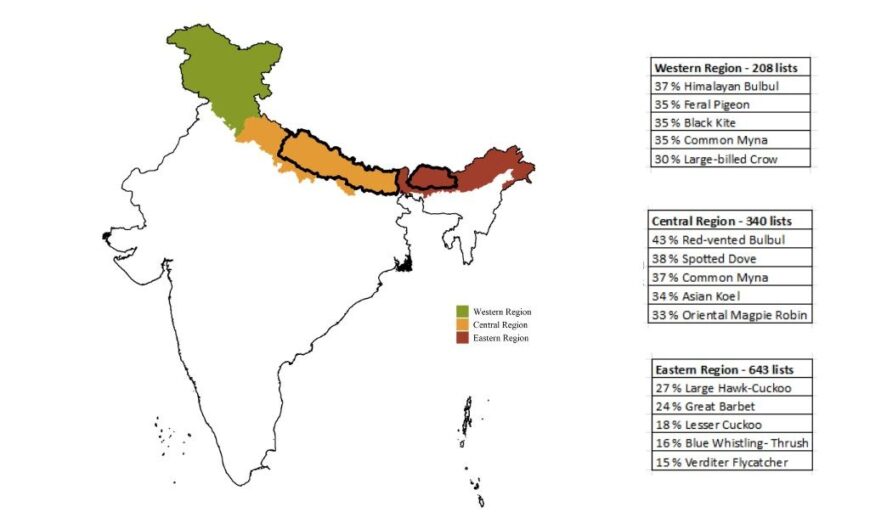
Fig. 4: Top five most commonly reported species in the himalayan regions based on the frequency of reporting in eBird during HBC 2024
Species Diversity
An impressive diversity of 644 species was recorded, with many species at their peak of the breeding season and singing away. You can view the full list of species here.
Western Himalaya (Jammu and Kashmir, Himachal Pradesh)
- In Jammu and Kashmir, birdwatchers recorded all the regional specialities, including the vibrant Orange Bullfinch and Spectacled Finch.
Central Himalayas (Uttarakhand, Nepal)
- The elusive Pale-footed Bushwarbler was recorded in Sal forests in the Uttarakhand foothills of the Uttarakhand Himalaya. Did you know that this special bird of the Himalayan foothills is also found in the Andaman and Nicobar Islands?
- Nepal is one of the last strongholds of the increasingly threatened Slender-billed Vulture. In good news, Birders in Nepal recorded both this species and White-rumped Vulture during the count.
Eastern Himalayas (West Bengal, Sikkim, Bhutan, Arunachal Pradesh)
- Rufous-necked Hornbill was reported from West Bengal, which is one of few places this species can still be seen.
- A beautiful flycatcher that’s not often seen – Ferruginous Flycatcher – was observed in both Arunachal Pradesh and Bhutan.
- Some very regionally restricted species Godlewski’s Bunting and Yunnan Nuthatch were recorded in Anjaw district in Arunachal Pradesh, a region where the coniferous forests start at 1000m and a whole new bird community exists.
- Both Wedge-billed Babblers – Cachar Wedge-billed Babbler and Sikkim Wedge-billed Babbler – were recorded completing this unique group!
- Slender-billed Oriole was reported from Bhutan which forms a real stronghold for this restricted species.
Trans-Himalaya (Ladakh, Lahaul and Spiti)
- Birders in Ladakh were rewarded with the super rare sighting of Lesser Grey Shrike in addition to the iconic Black-necked Crane.
HBC 2024 in India
In the Himalayan regions of India, 264 birdwatchers uploaded 950 lists, documenting a total of 607 species.
Table 4: No. of participants and lists from state and union territories in India (ordered by geography from west to east). The Himalayan regions in West Bengal are Alipurduar, Darjeeling, Jalpaiguri, and Kalimpong
| Region | # Participants | # Lists |
| Jammu and Kashmir | 84 | 29 |
| Ladakh | 36 | 9 |
| Himachal Pradesh | 68 | 28 |
| Uttarakhand | 172 | 82 |
| Sikkim | 102 | 23 |
| West Bengal | 200 | 37 |
| Arunachal Pradesh | 251 | 38 |
Table 5: Top 5 most frequently reported species in India
| Species | Reporting Frequency |
| Blue Whistling-Thrush | 26 % |
| Himalayan Bulbul | 25 % |
| Common Myna | 24 % |
| Oriental Turtle-Dove | 22 % |
| Large-billed Crow | 22 % |
HBC 2024 in Nepal
62 birdwatchers in Nepal recorded 350 species in 161 checklists! Participation was seen from five states/provinces.
Table 6: No. of participants and lists from state/ province in Nepal
| State/ Province | # Participants | # Lists |
| Bagmati | 114 | 40 |
| Gandaki | 21 | 11 |
| Province 1 | 14 | 8 |
| Sudur Pashchim | 9 | 4 |
| Province 5 | 3 | 2 |
Table 7: Top 5 most frequently reported species in Nepal
| Species | Reporting Frequency |
| Red-vented Bulbul | 58 % |
| House Crow | 54 % |
| Common Myna | 53 % |
| Asian Koel | 52 % |
| Rock Pigeon | 50 % |
Bhutan
42 birdwatchers recorded 294 species in 80 lists ! Participation was seen from nine districts. The Royal Society and Protection for Nature (RSPN) Bhutan played a crucial role in promoting this event in Bhutan.
Table 8: No. of Participants and lists from districts/county in Bhutan
| District/ County | # Participants | # Lists |
| Tsirang | 14 | 6 |
| Wangduephodrang | 9 | 5 |
| Zhemgang | 6 | 4 |
| Sarpang | 5 | 5 |
| Yangtse | 3 | 2 |
| Lhuentse | 2 | 2 |
| Thimphu | 2 | 2 |
| Bumthang | 1 | 1 |
| Chhukha | 1 | 1 |
Note: Due to the smaller number of checklists, it was not possible to calculate the Top 5 most frequently reported species in Bhutan.
How did Himalayan Bird Count 2024 did compared to previous years?
- Total Checklists: A significant decrease of 22.8% was observed in total checklists from 2023 to 2024.
- Participants: The number of participants also declined by 7.07% from 2023 to 2024.
- Species: While there was a slight decrease of 2.72% in the number of species recorded, this figure remained relatively stable.
Table 9: Summary of HBC 2022, 2023 and 2024
| HBC 2023 | HBC 2024 | % Change (Between 2023 and 2024) | |
| Total checklists | 1543 | 1191 | – 22.8 % |
| Participants | 396 | 368 | – 7.07 % |
| Species | 662 | 644 | – 2.7 % |
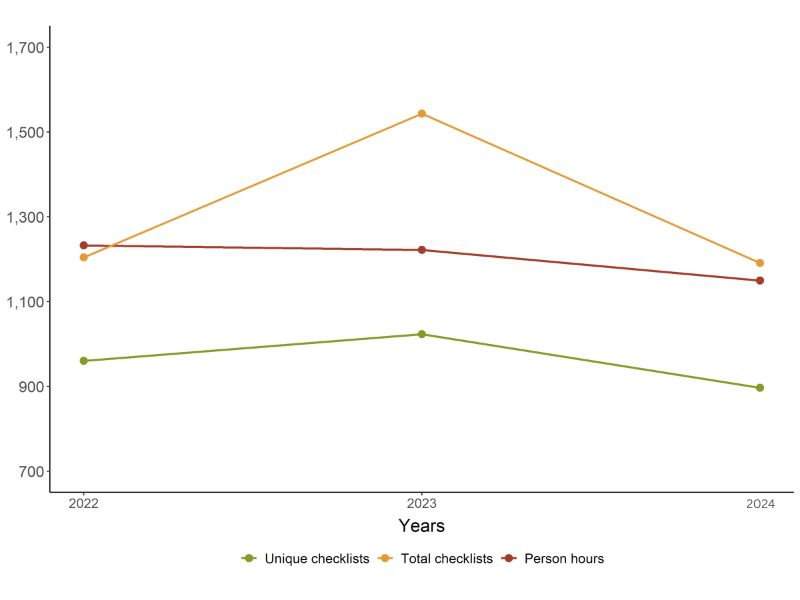
Fig. 5: Graph depicting decline in terms of unique lists (not including shared lists), total checklists (including shared lists) and person hours, from 2022 to 2024.
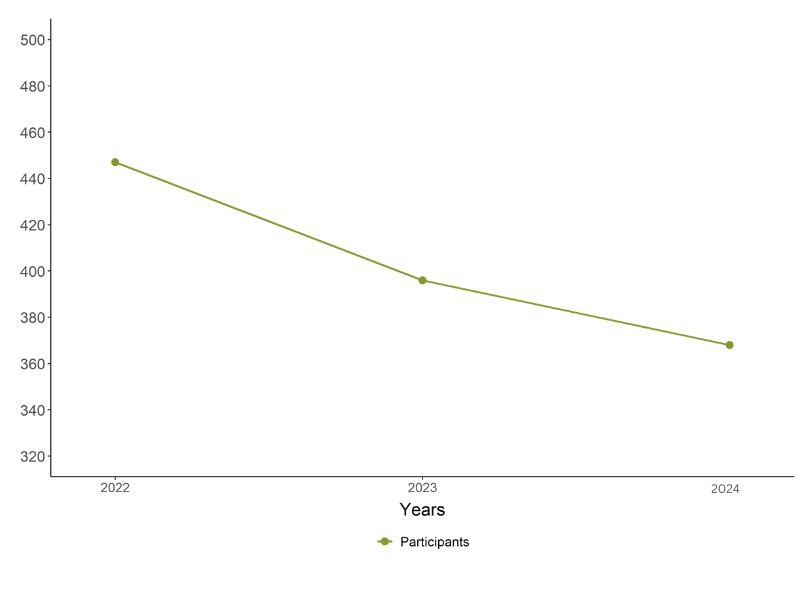
Fig. 6: Graph depicting decline in terms of number of participants from 2022 to 2024

Fig. 7: Graph showing slight increase in district participation
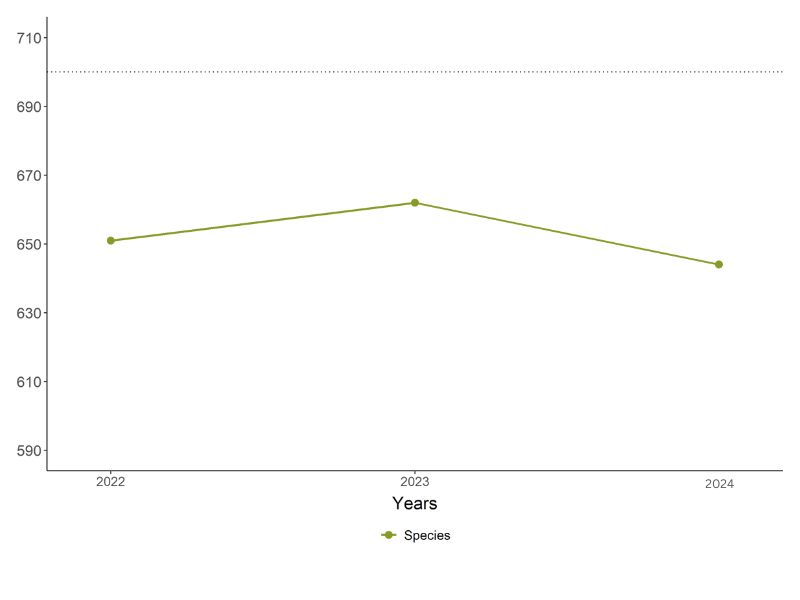
Fig. 8: Graph showing slight decline in species reported from HBC 2022 to HBC 2024
The Himalayan Bird Count has experienced a drop in both participation and the number of checklists in recent years highlighting a need to engage more nature enthusiasts into this important citizen science initiative. Expanding our community of bird watchers would help strengthen conservation efforts and deepen our understanding of these remarkable mountain ecosystems.
Stay Connected with Birds, Nature and Each Other
- The next HBC will be on 10 May, 2025.
- If you want to start your birdwatching journey or show others the joy of birding, there’s no need to wait until the next GBBC! You can start birding right away and upload your checklists to eBird. First, download these two important free apps: the Merlin Bird ID App and the eBird App. You can find ‘How to’ videos and webinars on Bird Count India’s YouTube channel.
- If you are new to birds and nature, consider subscribing to The Flock!
- For more information, you could also contact our Regional Coordinators listed here.
- To stay up-to-date with birding events across the country, bookmark this page: birdalliance.in.
- If you conduct regular bird or nature walks, please let us know so that we can list them here.
Header Image: Slender-billed Oriole Oriolus tenuirostris © Rajkumar Das / Macaulay Library

